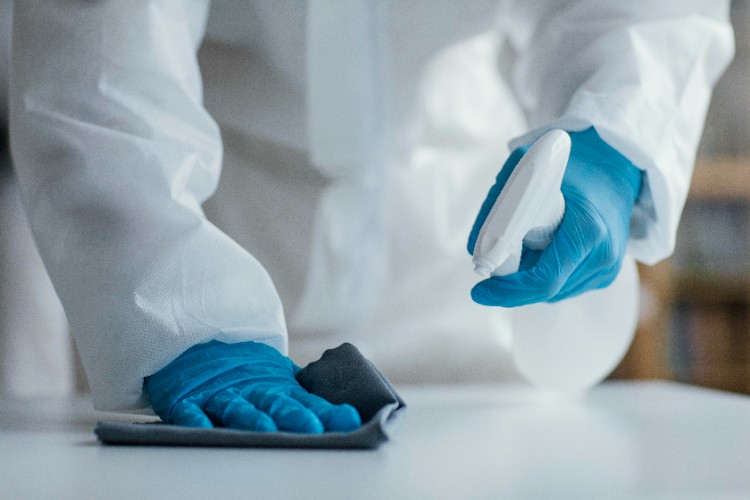Top Sanitizers for Food Factories

Why the Right Sanitizer Saves More Than Just Time
In our food processing world, sanitizing isn’t optional—it’s survival. We’ve learned that firsthand. Every surface in contact with food must be cleaned and sanitized.
But with dozens of sanitizing products out there, picking the best disinfectant for the food industry can feel like walking through a minefield.
We’ve tested and studied a wide range of options. Some wowed us. Others... not so much. Here’s what works, what we trust, and how you can keep your food contact surfaces safe and squeaky clean.
What Makes a Sanitizer "The Best"?
We’ve found that a food-safe sanitizer must tick at least six boxes:
· ✅ Kills bacteria, viruses and fungi
· ✅ Works within short contact time
· ✅ EPA and FDA approved
· ✅ Leaves no toxic residues
· ✅ Safe for food contact surfaces
· ✅ Reduces cross-contamination risks
Seems like a tall order, right? But some sanitizers do check all the boxes. Let’s dig into them.
Understanding Food Contact Surfaces
Before choosing a sanitizing product, identify where you’ll use it. Food contact surfaces include:
· Worktables
· Cutting tools
· Conveyor belts
· Packing machines
· Mixing tanks
Some surfaces are sensitive. Others tolerate tougher chemicals. The type of material matters as much as the sanitizer itself.
Top Sanitizer Types Used in Food Processing
We’ve worked in the trenches. We’ve scrubbed. We’ve sprayed. And here’s our list of sanitizers that actually get the job done.
1. Hypochlorite and Chlorine Dioxide
These chlorine-based sanitizers are industry classics.
Pros:
· Highly effective
· Works across a wide range of bacteria
· Easy to mix and apply
Cons:
· Can corrode metal
· Strong odor
· Strict contact time rules
Despite the downsides, they still rule in meat and poultry processing plants.
2. Hydrogen Peroxide
Hydrogen peroxide is a fan favorite among food safety teams.
Pros:
· Breaks down into oxygen and water
· Minimal residue
· Non-toxic when properly diluted
Cons:
· Not ideal for greasy surfaces
· Short shelf life
We use it when we want to sanitize safely and effectively without leaving chemical trails behind.
3. Quaternary Ammonium Compounds (Quats)
These synthetic sanitizers are great for non-food-contact areas.
Pros:
· Long-lasting surface protection
· No strong scent
· Easy to apply
Cons:
· Not always food-safe
· Requires rinsing
Quats work well for floors and walls but need caution near food prep areas.
The Game-Changer: Hypochlorous Acid
Let’s get real—HOCl changed everything for us. It's a naturally occurring compound our white blood cells produce. When made fresh with the right equipment, it becomes the ultimate sanitizer.
Why we swear by it:
· Destroys bacteria and viruses fast
· Requires no rinsing
· Safe for humans and food
· Breaks down into saline
We use Shine Hypochlorous Acid Generators to make HOCl on-site. No need to store harsh chemicals. No waste. Just clean, fresh sanitizing on demand.
Key Benefits of HOCl in Food Safety
Let me share some wins from the field:
· A dairy plant reduced contamination incidents by 68%
· A seafood factory boosted shelf life by switching from sodium hypochlorite to HOCl
· Our in-house trials showed 99.9% germ kill within 60 seconds
These aren’t lab claims. They’re real results we’ve experienced with our clients.
Why Contact Time Matters
Here’s a detail often overlooked—contact time. That’s how long a sanitizer needs to stay wet on the surface to work properly.
Some chlorine-based sanitizers require 10 minutes. That’s forever in a busy plant.
HOCl? It kills most pathogens in under 60 seconds. That’s a game-changer.
Cleaning and Sanitizing: Not the Same Thing
Let’s clear this up.
· Cleaning removes visible dirt
· Sanitizing kills what you can’t see
You must clean before you sanitize. Otherwise, your disinfectant fights grime, not germs.
We use mild detergents first, then follow with our HOCl-based sanitizing product. It’s a one-two punch that knocks out bacteria, viruses and fungi.
Chlorine-Based vs. New-Age Sanitizers
Sanitizer Type | Kill Time | Food Safe | Odor | Residue | Best Use Case |
Sodium Hypochlorite | 5–10 min | Yes | Strong | Yes | Raw meat surfaces |
Chlorine Dioxide | 2–5 min | Yes | Mild | Minimal | Water systems |
Hydrogen Peroxide | 1–2 min | Yes | None | No | Fruits, ready-to-eat zones |
HOCl (Hypochlorous) | <1 min | Yes | Fresh | No | High-contact areas, tools |
Quaternary Ammoniums | 10+ min | No | Low | Yes | Storage rooms, non-food areas |
What Regulatory Agencies Say
The Environmental Protection Agency (EPA) and the Food and Drug Administration (FDA) regulate what we can and can’t use in food production.
Both agencies approve:
· Hypochlorites
· Hydrogen peroxide
· Chlorine dioxide
· HOCl
Shine Hypochlorous Acid Generators produce HOCl within EPA guidelines. That’s how we guarantee safety and compliance without extra paperwork.
How We Prevent Cross-Contamination
One sneaky germ can bring an entire line to a halt. We take this seriously.
Our process:
· Assign dedicated sanitizers to zones
· Use color-coded sprayers
· Sanitize food contact surfaces after each shift
· Test for ATP and swab for bacteria weekly
And when we use HOCl, we don’t have to rinse or worry about leftover residue. That keeps the process clean and quick.
Final Thoughts From the Frontlines
We’ve tried everything—from harsh chlorine to homemade vinegar sprays. But nothing beats HOCl for its blend of power and safety.
It works where sodium hypochlorite can’t. It’s safer than quats. It sanitizes food contact surfaces without side effects.
And because we make it fresh using Shine Hypochlorous Acid Generators, we skip the storage, shipping and dilution nightmares.
So what’s the best disinfectant for the food industry? We say HOCl. And once you use it, you won’t look back.
